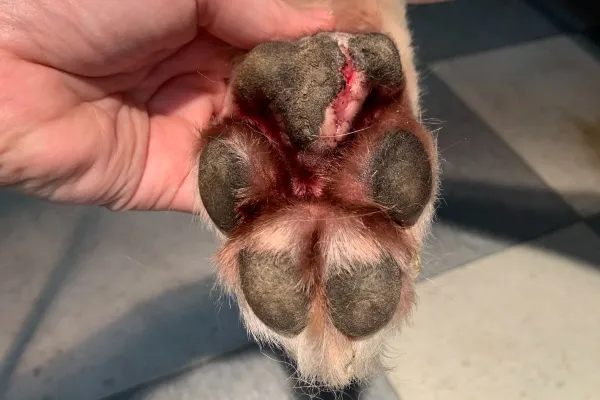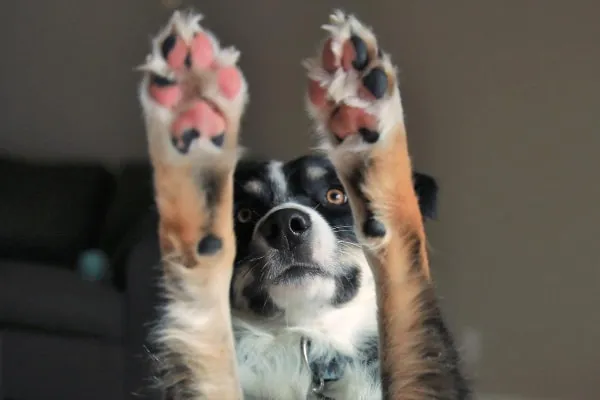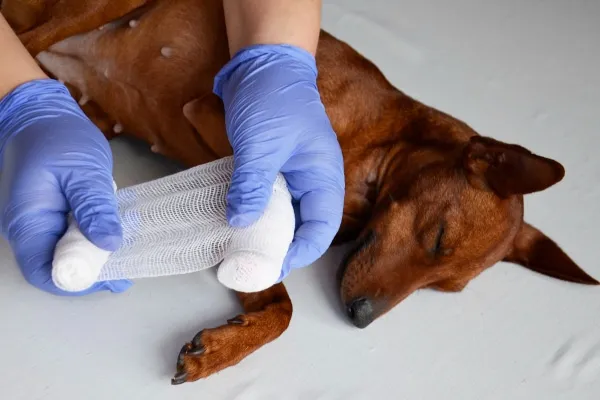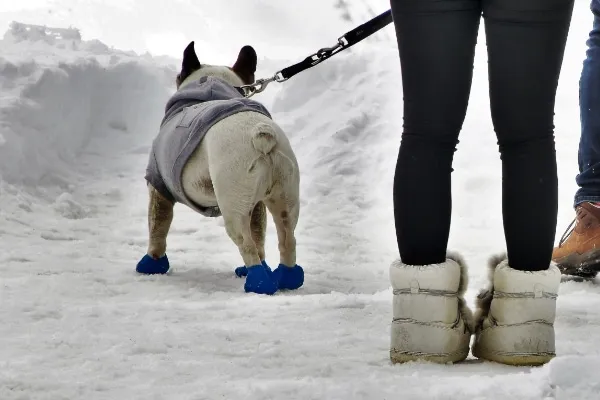A torn dog paw pad can be a distressing experience for both you and your canine companion. These tough, leathery pads are crucial for your dog’s mobility and comfort, acting as shock absorbers, providing traction, and protecting their feet from the elements. When they get injured, it’s essential to know how to respond effectively. This guide will walk you through recognizing, treating, and preventing paw pad injuries, ensuring your dog can get back on their feet as quickly and comfortably as possible.
Understanding Dog Paw Pad Injuries
Dog paw pads are designed to withstand significant wear and tear. However, their constant contact with the ground exposes them to various hazards. Understanding the different types of injuries can help you identify the problem and administer appropriate first aid.
Common Types of Paw Pad Injuries
- Foreign Bodies: Sharp objects like glass, thorns, nails, or sticks can become embedded in the paw pad, causing punctures and pain.
- Cuts and Lacerations: Abrasions from sharp objects can lead to cuts on the paw pad. In some cases, dry or cracked paw pads can also split open.
- Flaps: These are more extensive than simple cuts, often occurring when a sharp object slices horizontally across the pad, creating a loose flap of skin. Untreated cuts can also develop into flaps as the tissue tears.
- Burns: Paw pads are susceptible to burns from hot surfaces like asphalt or concrete, especially during hot weather. Cold temperatures, ice melt products, and caustic substances can also cause burns.
- Abrasions: Rough surfaces like concrete or abrasive materials can wear down the paw pads, causing raw and painful abrasions.
- Ingrown Toenails: Overly long nails can curl and penetrate the paw pad, creating a painful wound that can lead to infection.
 A close-up of a dog's paw with a visible cut on the pad
A close-up of a dog's paw with a visible cut on the pad
Recognizing a paw pad injury is the first step to effective treatment.
Signs Your Dog Has a Paw Pad Injury
If your dog sustains a paw pad injury, you might observe several tell-tale signs. Acting promptly upon noticing these symptoms is crucial for their well-being.
- Lameness or Limping: This is often the most obvious sign. Your dog may suddenly start limping or avoid putting weight on the affected paw.
- Excessive Licking or Chewing: Dogs will often lick or chew at an injured area to soothe pain or clean the wound.
- Bleeding: You may notice blood on the ground where your dog has walked or directly from the paw pad.
- Whining or Crying Out: Your dog might vocalize pain when the injured paw is touched or when they try to put weight on it.
- Swelling or Redness: The paw pad or the surrounding area may appear swollen or inflamed.
- Visible Damage: You might see a cut, flap, puncture, or foreign object lodged in the paw pad.
- Unwillingness to Move: In severe cases, your dog might refuse to walk or stand on the injured leg.
First Aid Steps for a Torn Dog Paw Pad
When you suspect your dog has a torn paw pad, remain calm and follow these steps to provide immediate first aid. Your quick actions can significantly impact the healing process and prevent further complications.
1. Assess Your Dog’s Overall Condition
Before approaching the injured paw, comfort your dog and assess their demeanor. If your dog is in severe pain or distress, they may react defensively, even if they are usually well-behaved. If your dog is in too much pain for you to safely examine their paw, it’s best to proceed directly to veterinary care rather than risking a bite.
2. Carefully Inspect the Paw
If it’s safe to proceed, gently examine the injured paw. Look at the top and bottom, the pads themselves, and the spaces between the toes. Try to determine the nature of the injury: is it a cut, a flap, a puncture, a burn, or is there a foreign object present? This assessment will guide your next steps.
 A dog being gently held while its paw is examined
A dog being gently held while its paw is examined
Gentle inspection is key to understanding the extent of the paw pad injury.
3. Remove Foreign Objects (If Safe) and Control Bleeding
- Foreign Objects: If you spot a small, superficial foreign object, you might be able to carefully remove it with clean tweezers. However, if the object is deeply embedded, large, or you suspect it has hit a blood vessel, nerve, or joint, do not attempt to remove it yourself. Instead, seek immediate veterinary attention.
- Bleeding: For active bleeding, apply firm, even pressure to the wound using a clean cloth or paper towel. Minor cuts should stop bleeding within a few minutes. If the bleeding is heavy and persists for more than 10-15 minutes despite pressure, contact your veterinarian immediately, as this could indicate a more serious issue.
4. Clean the Wound
Once bleeding is controlled, it’s crucial to clean the wound to prevent infection.
- Cool Water: Gently flush the wound with cool water. This can help reduce swelling and ease pain, especially if the injury is a burn.
- Antiseptic Solution: You can also use a mild, pet-specific antiseptic soap or a solution like chlorhexidine or Betadine (diluted according to veterinary instructions) to clean the area.
- Re-bleeding: Be aware that cleaning the wound might cause it to bleed a little again. If this happens, reapply gentle pressure until the bleeding stops.
5. Apply a Clean Bandage
A bandage can protect the injured paw pad from further damage, keep the wound clean, and help control minor bleeding.
- Materials: Use clean, sterile materials such as gauze pads and cohesive veterinary wrap (vet wrap).
- Application: Wrap the paw securely but not too tightly. Ensure you can slip one or two fingers between the bandage and your dog’s leg at the top. A bandage that is too tight can cut off circulation, leading to serious complications.
- Monitoring: Watch for signs of a too-tight bandage, such as swelling of the toes (if they are exposed), coldness to the touch, or discoloration.
 A dog's paw being carefully bandaged with sterile gauze and vet wrap
A dog's paw being carefully bandaged with sterile gauze and vet wrap
Proper bandaging is essential for protection and to prevent infection.
6. Contact Your Veterinarian
Even after providing first aid, it’s vital to consult your veterinarian. They can properly assess the injury, determine the best course of treatment, and advise on follow-up care. They may prescribe antibiotics, pain medication, or specific ointments to aid healing.
- Daily Checks: While waiting for your veterinary appointment, and as directed by your vet, check and change the bandage daily. This allows you to monitor the wound for signs of infection (increased redness, swelling, discharge, or foul odor) and ensures the bandage isn’t causing any circulation issues.
Veterinary Treatment for Paw Pad Injuries
At the veterinary clinic, your dog will undergo a thorough examination.
- Physical Exam: The veterinarian will conduct a full physical exam to rule out other injuries and then focus on the paw. They will palpate the paw to check for bone or joint damage and inspect the wound for foreign bodies or deeper tissues affected.
- Diagnostic Imaging: If a foreign object is suspected or if there’s concern about bone involvement, X-rays may be recommended.
- Wound Management: For cuts or flaps, veterinarians typically do not suture paw pads closed because the tissue doesn’t hold stitches well and movement can cause them to tear out. Instead, they will thoroughly clean the wound and may apply topical treatments like antibacterial ointments or soothing creams.
- Bandaging and E-Collars: A protective bandage will be applied to keep the wound clean, prevent re-injury, and help deliver medication. In some cases, an Elizabethan collar (e-collar or cone) may be necessary to prevent your dog from licking or chewing at the bandage and wound.
- Pain Management: Your vet will likely prescribe pain relief medication to keep your dog comfortable during the healing process.
Patience and Communication
Paw pad injuries can take time to heal due to the constant pressure and movement your dog’s paws endure. Be patient, follow your veterinarian’s instructions precisely, and maintain open communication with your vet if you have any concerns about the healing progress or notice any signs of infection.
Preventing Future Paw Pad Injuries
While not all injuries can be prevented, you can take several steps to minimize the risk of your dog suffering from torn paw pads.
- Temperature Awareness: Avoid walking your dog on hot pavement, especially during the hottest parts of the day. A good rule of thumb is if you can’t comfortably hold the back of your hand on the surface for 7-10 seconds, it’s too hot for your dog’s paws. Similarly, protect paws from extreme cold and ice melt products.
- Protective Footwear: Consider using dog booties, especially for walks on rough terrain, hot or cold surfaces, or when using ice melt. Ensure the booties fit well and don’t restrict circulation.
- Regular Paw Inspections: After walks, especially in areas with potential hazards like foxtails or rough ground, inspect your dog’s paws for cuts, abrasions, or embedded objects.
- Nail Trimming: Keep your dog’s nails trimmed regularly. Overgrown nails can cause imbalances in gait and can potentially grow into the paw pad.
- Hazard Awareness: Be mindful of your surroundings when walking your dog. Scan paths and trails for sharp objects, broken glass, or other potential dangers.
- Paw Pad Conditioning: Some owners find that regular paw balm application can help keep pads supple and less prone to cracking.
 A dog wearing protective booties while walking outdoors
A dog wearing protective booties while walking outdoors
Protective dog boots can be a great asset in preventing paw injuries.
Being prepared with a dog first-aid kit and understanding these first-aid principles will empower you to confidently manage a torn dog paw pad injury. Remember, your veterinarian is your most valuable resource for professional advice and treatment. With proper care and prevention, you can help your dog maintain healthy and happy paws.
